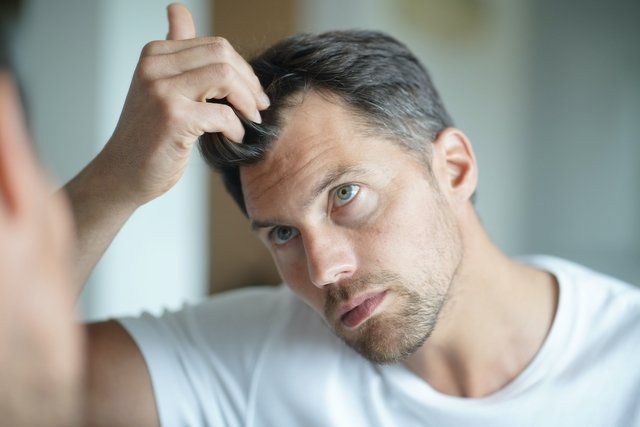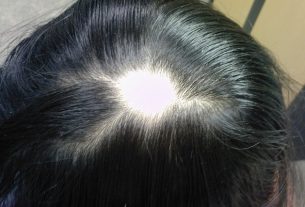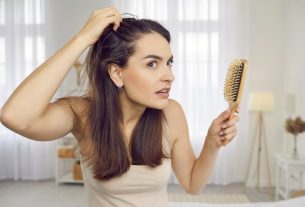Androgenetic alopecia, or baldness, is hair loss due to a genetic predisposition, which leads to the growth of thinner and thinner hair, which can occur in men and women.
Hair loss can begin at any age after puberty, but is more common in older people, especially after the age of 50 and if there is a family history of baldness.
When androgenetic alopecia is suspected, it is recommended to consult a dermatologist to confirm the diagnosis and initiate appropriate treatment. Treatment can be done with medications such as minoxidil and finasteride, hair transplant or laser therapy, for example.

Main symptoms
The main symptoms of androgenetic alopecia are:
- Fine hair strands;
- Thinner hair;
- Hair loss, especially on the top of the head;
- Receding hairline.
Hair loss typically begins after puberty and, although it is slow, tends to get worse over time. Additionally, the symptoms of androgenetic alopecia tend to develop differently in men and women.
Female androgenetic alopecia
In female androgenetic alopecia, it is common for the front part of the scalp to be more affected, where thinner and thinner hair can be noticed, but without altering the hair growth line on the forehead. See the first signs of androgenetic alopecia, or baldness, in women.
Although sometimes androgenetic alopecia in women can also cause increased hair loss, it is rare for the top of the head to be affected or for complete hair loss to occur.
Male androgenetic alopecia
Male androgenetic alopecia tends to be initially noticed by increased hair growth on the forehead. Furthermore, it is common for the top of the head to also be affected over time.
Possible causes
Androgenetic alopecia is caused by an abnormal response of hair follicles on the scalp, which is where hair grows, to androgen hormones such as dihydrotestosterone due to a genetic predisposition.
Although androgenetic alopecia can begin to develop after puberty, it is more common in older men and women after menopause, especially after the age of 50 and with a family history of baldness.
How to confirm the diagnosis
The diagnosis of androgenetic alopecia is made by a dermatologist based on the identification of the hair loss pattern and, in some cases, a family history of baldness.
Taking care of your health has never been easier!
In addition, the dermatologist can perform a dermoscopy exam, to observe the hair in more detail, and recommend tests, such as the measurement of ferritin or thyroid hormones in the blood and, sometimes, a scalp biopsy, to confirm the diagnosis. . Check out other causes of hair loss.
How the treatment is carried out
The treatment of androgenetic alopecia can initially be done by applying medications such as minoxidil and finasteride in the form of solutions, gel or foam to the scalp. However, results may take between 4 to 8 months to be noticed.
In the most serious cases, for the treatment of androgenetic alopecia, finasteride, minoxidil and, especially for women, spironolactone or cyproterone may be indicated, for example, in tablet form.
In addition, sometimes hair transplantation can also be opted for to correct hair defects, or laser therapy to stimulate the growth of new hair. Discover the main ways to treat baldness.
Is there a cure for androgenetic alopecia?
Androgenetic alopecia has no cure. However, in some cases it is possible to stop hair loss through appropriate treatment, which allows new hair to grow, improving appearance.
Read too: Is alopecia curable? 6 treatment options
share the information
Bibliography
- YORK, Katherine et al. A review of the treatment of male pattern hair loss. Expert Opin Pharmacother. Vol.21, n.5. 603-612, 2020
- UPTODATE. Patient education: Androgenetic alopecia in men and women (Beyond the Basics). 2022. Disponível em: <https://www.uptodate.com/contents/androgenetic-alopecia-in-men-and-women-beyond-the-basics>. Acesso em 23 fev 2023
- STATPEARLS. Androgenetic Alopecia. 2022. Available at: <https://www.ncbi.nlm.nih.gov/books/NBK430924/>. Accessed on February 23, 2023
- NESTOR, Mark S. et al. Treatment options for androgenetic alopecia: Efficacy, side effects, compliance, financial considerations, and ethics. J Cosmet Dermatol. Vol.20, n.12. 3759–3781, 2021
- LOLLI, Francesca et al. Androgenetic alopecia: a review. Endocrine. Vol.57, n.1. 9-17, 2017
- STARACE, Michela et al. Female Androgenetic Alopecia: An Update on Diagnosis and Management. Am J Clin Dermatol. Vol.21, n.1. 69-84, 2020
- BRAZILIAN SOCIETY OF DERMATOLOGY. Androgenetic Alopecia. Available at: <https://www.sbd.org.br/doencas/alopecia-androgenetica/>. Accessed on February 23, 2023

Sign up for our newsletter and stay up to date with exclusive news
that can transform your routine!
Warning: Undefined array key "title" in /home/storelat/public_html/wp-content/plugins/link-whisper-premium/templates/frontend/related-posts.php on line 12
Warning: Undefined array key "title_tag" in /home/storelat/public_html/wp-content/plugins/link-whisper-premium/templates/frontend/related-posts.php on line 13



